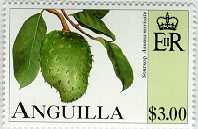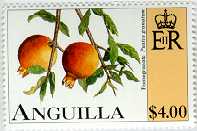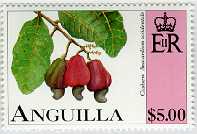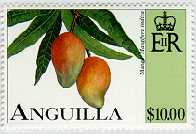
The Soursop plant favours the red, mineral-rich soil called "Red Bottom", which accounts for a large percentage of Anguilla's arable land. The Soursop usually assumes a heart-like shape, but is known to also grow round or irregular.
The fruit is green in colour with a tough skin with brittle thorn-like
projections. A milk-coloured juice is extracted from the pulp
and made into drink. Adding water and other desired spices, the
Soursop also makes a delicious frozen dessert localled called
"Special". The fruit can also be eaten unprocessed.

The Pomegranate can survive in relatively arid conditions, but naturally thrives best in well watered regions. The plant with its narrow leaves and lush green appearance is grown also as an ornamental plant.
The fruit, which matures in early spring, ripens to a pinkish red
or orange, and is usually found with a bell-shaped flute at
the top. The compacted grain-like seeds are each surrounded with a
membrane of tart juice and pulp, which is essentially the
edible portion of the Pomegranate.

Like the Soursop and Mango, the Cashew is found growing primarily in red soil. The trees cast their pungent blossoms in early spring and the fruits mature in about sixty days.
The kidney-shaped nut at the end of the pedicel or swollen stark
of the flower is the actual fruit. The nut is dried and roasted
and the kernel extracted. The Cashew Apple (or Cherry as it is
sometimes called) usually ripens to a red or yellow colour and
can be processed into jam or stewed. The Cashew nut when placed
in the ring, turns a common marble game into a keen test of skill.

The Mango can be considered Anguilla's "prize fruit". The Mango like the Soursop thrives well in red soil and is found largely in the easter section of the island. The famous Mango garden in the Chalvilles village supports about 60% of the island's Mango.
The fruit, which is abundant in May - July, provides a
considerable source of income for local owners, as the fruit is
sold quite profitably. The succulent fruit is widely eaten in
its ripened form, but can also be made into preserves. Varieties
of the Mango found locally include: Bull Head, Turkey Breast
and Rosy Cheek.
Back to "Stamps of Anguilla"